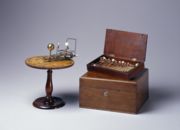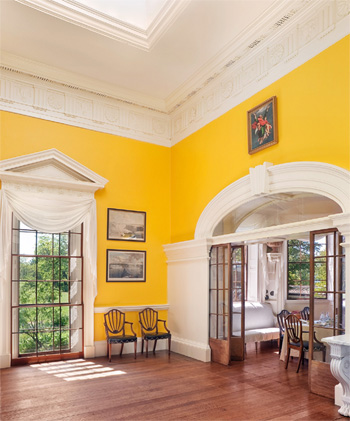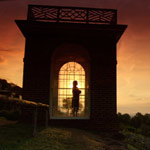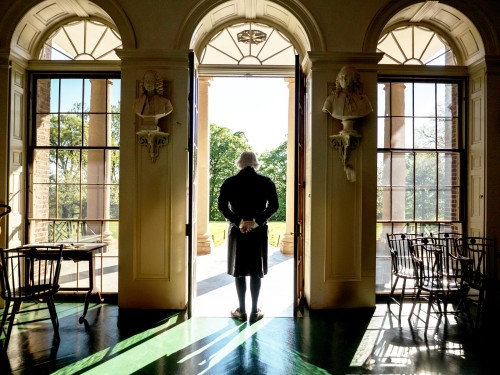
The Restoration and Collections Department is responsible for the care, preservation, study, and public presentation of the Monticello house and the Thomas Jefferson Foundation's collection of objects related to Thomas Jefferson, his family, and their lives at Monticello. Since the Foundation purchased Monticello in 1923, several generations of curators have worked to locate and acquire the approximately 5000 objects in this collection. The process is ongoing, and involves a combination of documentary and provenance research and connoisseurship.
Videos from the Collection and Restoration Team

Jefferson's Obelisk Clock. If the Great Clock in the entrance Hall was the most important public clock at Monticello, the Obelisk Clock was Jefferson's most important private one.

John Locke returns to Monticello after getting some TLC

Restoring the Textile Workshop at Monticello

The Polygraph Copying Machine

Move-in Day at Monticello. With restoration of the upper floors underway and not much historical evidence to go on, our Restoration and Curatorial teams were tasked with finding a solution around those narrow stairways.

Preparing a Distemper Paint

Painting with Distemper Paint

"I remember the interior of that cabin" - Finding a Lost Diary
 Monticello houses the premier collection for the comprehensive study of Thomas Jefferson. Objects relate to virtually every aspect of Jefferson's diverse interests, and his and his family's activities. These include fine and decorative arts (paintings, prints, sculptures, furniture, textiles, ceramics, silver, glass, and clocks), natural history specimens, maps, books, scientific instruments, Native American materials, writing and drafting implements, musical instruments, and personal items such as clothing, jewelry, sewing implements, and pocket accessories. About 75 percent of these collections are exhibited; the remainder is available for study. Jefferson originally owned about 60 percent of the objects on display.
Monticello houses the premier collection for the comprehensive study of Thomas Jefferson. Objects relate to virtually every aspect of Jefferson's diverse interests, and his and his family's activities. These include fine and decorative arts (paintings, prints, sculptures, furniture, textiles, ceramics, silver, glass, and clocks), natural history specimens, maps, books, scientific instruments, Native American materials, writing and drafting implements, musical instruments, and personal items such as clothing, jewelry, sewing implements, and pocket accessories. About 75 percent of these collections are exhibited; the remainder is available for study. Jefferson originally owned about 60 percent of the objects on display.

Highlights of the collection include over 300 pieces of furniture acquired by Jefferson in Williamsburg, Philadelphia, New York, London, and Paris, or made by Monticello slaves in Monticello's own joinery; scientific instruments, such as telescopes, theodolites, botanic microscopes; approximately 500 household accessories, including French, English, American, and Chinese ceramics, and French, English, and American silver; and 500 works of art, including sculptures (chiefly portraits of men Jefferson admired &— Washington, Lafayette, Franklin, etc.), engravings and paintings, and portraits of Jefferson himself, including the 1805 "Edgehill" portrait by Gilbert Stuart, co-owned with the Smithsonian's National Portrait Gallery, and the terra cotta patinated bust of Jefferson done from life by Jean-Antoine Houdon, given to the Foundation by The Gilder Lehrman Collection.
 Recent acquisitions include scientific instruments such as an orrery and solar microscope; a pocket globe and pocket telescope; engravings; medals; books; high-quality painted reproductions of paintings owned by Jefferson (the Joseph Wright portrait of George Washington, Joseph Boze's portrait of Lafayette, Mather Brown's portraits of John Adams and Thomas Jefferson, and portraits of Isaac Newton and Francis Bacon from the Royal Society, London, as well as his copy of the Apotheosis of St. Paul, now in the Louvre); a filing press and Campeachy chair made by African-American woodworkers in Monticello's joinery, several French chairs; and John Binn's engraving of the Declaration of Independence.
Recent acquisitions include scientific instruments such as an orrery and solar microscope; a pocket globe and pocket telescope; engravings; medals; books; high-quality painted reproductions of paintings owned by Jefferson (the Joseph Wright portrait of George Washington, Joseph Boze's portrait of Lafayette, Mather Brown's portraits of John Adams and Thomas Jefferson, and portraits of Isaac Newton and Francis Bacon from the Royal Society, London, as well as his copy of the Apotheosis of St. Paul, now in the Louvre); a filing press and Campeachy chair made by African-American woodworkers in Monticello's joinery, several French chairs; and John Binn's engraving of the Declaration of Independence.
In June 2010, the Curatorial department unveiled several new initiatives as part of New Perspectives on Domestic Life at Monticello. These have ensured that Monticello now reflects the very latest curatorial research. The interior of the South Pavilion, the first structure built on Monticello mountain and the site of Martha and Thomas Jefferson's early life together, now evokes its appearance in 1772 after Jefferson spent a large sum to prepare his one-room living quarters for his bride. The Wine Cellar, including one side of the famous wine dumbwaiter, has been restored and opened for visitors to enter for the first time ever, and curators organized an exhibition entitled Crossroads: Domestic Work at Monticello on the cellar level of the house.
 The centerpiece of this initiative was the reinterpretation of Monticello's dining room, now painted a vibrant chrome yellow, and containing a carpet, sideboard, serving table, French sofa, and works of art that were not previously there. This restoration effort has enabled a fuller understanding of how the room functioned for Jefferson, his family and guests, and the enslaved domestic servants who prepared and served the meals.
The centerpiece of this initiative was the reinterpretation of Monticello's dining room, now painted a vibrant chrome yellow, and containing a carpet, sideboard, serving table, French sofa, and works of art that were not previously there. This restoration effort has enabled a fuller understanding of how the room functioned for Jefferson, his family and guests, and the enslaved domestic servants who prepared and served the meals.
Monticello curators have been responsible for the ongoing restoration and refurbishment of Monticello's dependencies, or work spaces beneath the house, including the Kitchen, Cook's Room, Beer Cellar, Storage Cellars, and Wine Cellar.

In addition to their work with the domestic interiors at Monticello, members of the curatorial department also played major roles in the creation of the David M. Rubenstein Visitor Center. Monticello's curatorial department was responsible for the interpretive features, including the film Thomas Jefferson's World and the four exhibitions in the Robert H. and Clarice Smith Gallery.
Recent work includes Mulberry Row and the Landscape of Slavery at Jefferson's Monticello, a project funded partially by the National Endowment for the Humanities that will interpret Mulberry Row, the main plantation street to the south of the Monticello house, site of dwellings for enslaved house servants and light industries run by slaves.

